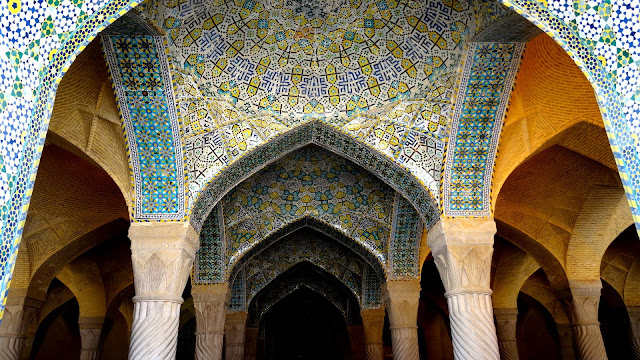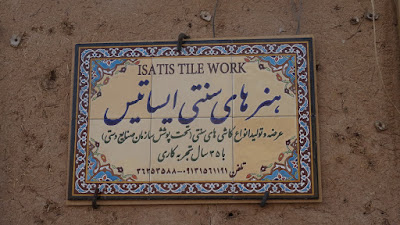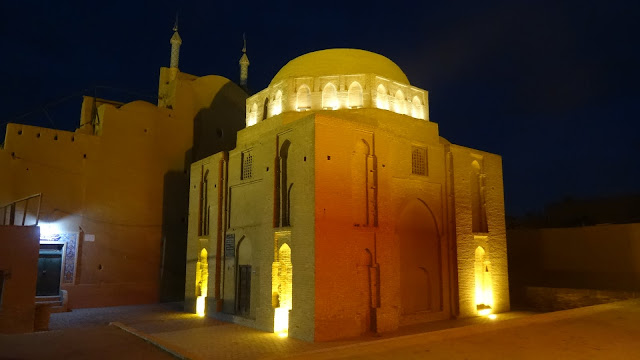Iran (20.4.-1.5.2017)
Route http://iran-2017.blogspot.co.at/
Tehran - Gandj Nameh - Hamedan - Kangavar (Anahita Temple) - Bisotun - Kermanshah - Chogha Zanbil - Shushtar - Ahvaz - Shiraz - Persepolis - Yazd - Nain - Isfahan
Der Reiseleiter / The Guide: Farzad from Isfahan, lived 10 years in Cologne
Die Gruppe / The Group: 17 Austrians, 1 Polish (very lovely people - it was our very first group travel)

Fahrer und Bus / Driver and Bus
(beim Einsteigen macht der Spruch an der Windschutzscheibe doch etwas nachdenklich)

(beim Einsteigen macht der Spruch an der Windschutzscheibe doch etwas nachdenklich)
Tehran
Golestan Palace
One of the oldest historic monuments in the city of Tehran, and of world heritage status. Belongs to a group of royal buildings that were once enclosed within the walls of Tehran's arg ("citadel"). It consists of gardens, royal buildings, and collections of Iranian crafts and European presents from the 18th and 19th centuries.
One of the oldest historic monuments in the city of Tehran, and of world heritage status. Belongs to a group of royal buildings that were once enclosed within the walls of Tehran's arg ("citadel"). It consists of gardens, royal buildings, and collections of Iranian crafts and European presents from the 18th and 19th centuries.


Park-e Mellat

Park-e Abo Atash


Modern Tehran and Elburz range

The inscriptions of Gandj Nameh
The left one was ordered by Darius the Great (521-485 BC), the right one by Xerxes the Great (485-65 BC). Both sections were carved in three ancient languages: Old Persian, Neo-Babylonian and Neo-Elamite. The inscriptions start with praise of the Zoroastrian God (Ahura Mazda) and describe the lineage and deeds of the mentioned kings.



Hamedan
Ester and Mordekhai Mausoleum (1300 AD), Synagogue

Synagogue


Anahita Temple
Built by Achaemenian Emperor Ardeshir II (Artaxerxes II), 404 BC to 359 BC in honour of Ardevisur Anahita, the female guardian angel of waters. According to classic historians, the temple was a vast palace, almost a mile in circumference. Every tile of the floors was made of silver, and the whole building was apparently faced with bricks of silver and gold. It was first plundered by Alexander in 335 BC, then further stripped during the reigns of Antigonus (BC 325-301) and Seleucus Nicator (BC 312-280) [web]



Bisotun
Herakles Relief, 148BC
Bisotun Caves, 35.000BC

Darius Bas-Relief, 500BC



(web)
Kermanshah
Taq-e Bostan, ca 600BC, Bas-Relief Koshrow II., hunting scenes







Tekyeh Moaven al-Molk, 19. c, Iran's finest Hosseinieh, a distinctively Shiite shrine where plays are acted out during the Islamic month of Moharram to commemorate the martyrdom in 680 of Imam Hossein at Karbala [lonely planet]







Kermanshah Bazar


Will be worn only in private homes - unfortunately





Diwan Dinner

On the Road to Ahvaz
Unsere Strecke betrug ca 2.600km - viel Zeit im Bus, viel Zeit zum Schauen, Lesen, Reden, Schlafen. Die Landschaft schwankt zwischen sehr flach und recht gebirgig, zwischen karger Halbwüste und reiner Wüste. Abwechslungsreich, ja, aber in Maßen - daher gibt es hier nicht viele Landschaftsfotos zu sehen ...We traveled 2.600km through a landscape which changes between half dessert and full dessert - not very different throughout. So there are not that many landscape photos here to be shown ...




Picknick mit Melone, Schafskäse und Fladenbrot

Curious tourists meet relaxed Iranians- extremely polite and hospitable people ...





Choga Zanbil
Built ca1250 BC by the king Untash-Napirisha, mainly to honor the great god Inshushinak. It's unlikely that many people, besides priests and servants, ever lived there. The complex is protected by three concentric walls which define the main areas of the 'town'. The inner area is wholly taken up with a great Ziggurat dedicated to the main god, which was built over an earlier square temple.The area holds eleven temples for lesser gods [wiki]
Ziggurat: a massive structure built in ancient Mesopotamia and the western Iranian plateau. Had the form of a terraced step pyramid of successively receding stories or levels [wiki]
(web)
Reconstruction
(web)
Shushtar
Was built on an island in the Karun river during the Sassanid era (224-542) with a complex irrigation system. It was registered on UNESCO's list of World Heritage Sites in 2009. Shushtar infrastructure included water mills, dams, tunnels, and canals [wiki]
Siesta, to the sounds of waterfalls
1942 a small power station was built
On the Road to Shiraz
Another picknick
Shiraz
The sixth-most-populous city of Iran (1,7 Mill inhabitants) and is located in the southwest of Iran on the Roodkhaneye Khoshk (The Dry River) seasonal river. It has a moderate climate and has been a regional trade center for over a thousand years.Shiraz, the city of Mosques, Mausoleums and Shrines - beautiful ones, indeed!

Many beautiful old wooden houses are not being restored - rather knocked down to make room for new developments, sad.



Armghah-e Shah-e Cheragh
This mosque houses the tomb of the brothers Ahmad and Muhammad, sons of Mūsā al-Kādhim. They two took refuge in the city during the Abbasid persecution of Shia Muslims [wiki]




(web, David Holt)







Masjed-e Jame Atiq (Freitagsmoschee)
One of the oldest mosques in Iran and a relic of the days of the Saffarid Amr bin Leys’s reign (9th century). The construction of the mosque started in 894 as an act of thanksgiving following the victory of Amr Ley's forces over the armies of the Abbassid Caliph al-Movaffaq.
The mosque has witnessed numerous catastrophes, being rebuilt and restored several times, especially in the 12th and 13th centuries, during the reign of the Atabak rulers of Fars, and in the 16th through 18th century AD, during the Safavid epoch. The restoration of the mosque has continued during the reign of Pahlavi dynasty [IranianTours]





Masjed-e Nasir al-Molk
This mosque includes extensive colored glass in its facade, and displays other traditional elements such as the Panj Kāse ("five concaved") design. It is named in popular culture as the Pink Mosque, due to the usage of considerable pink color tiles for its interior design [wiki]






Seyyed Aladdin Hossein Shrine
Mausoleum of Sayyed Aladdin Hossein, one of the sons of the seventh Iman.

(web)






Masjed-e Vakil
This mosque was built between 1751 and 1773, and was restored in the 19th century during the Qajar period. Vakil means regent, the title used by Karim Khan, the founder of Zand Dynasty. Shiraz was the seat of his government [wiki]







Imamzadeh Ali Ebn Hamze Mausoleum
Built in the 19th century over the tomb of Emir Ali, a nephew of Shah Cheragh who also died here while en route to Khorasan to help Imam Reza. This shrine is the latest of several earlier incarnations destroyed by earthquakes. Highlights include the Shirazi dome, dazzling Venetian mirror work [lonely planet]


Aramghah-e Hafez
The poet Hafez was born in Shiraz in 1315 and died there in 1390. A beloved figure of the Iranian people, who learn his verses by heart, Hafez was prominent in his home town and held a position as the court poet. In his memory, a small, dome-like structure was erected in Shiraz near his grave at Golgast-e Mosalla gardens in 1452. The gardens, now known as Musalla Gardens featured in Hafez's poetry.


Persepolis
The earliest remains date back to 515 BC. It exemplifies the Achaemenid style of architecture. UNESCO declared the ruins of Persepolis a World Heritage Site in 1979.Darius I ordered the construction of the Apadana (audience hall) and the Council Hall (Tripylon or the "Triple Gate"), as well as the Imperial Treasury and its surroundings. These were completed during the reign of his son, Xerxes I. Further construction of the buildings on the terrace continued until the downfall of the Achaemenid Empire. After invading Persia in 330 BC, Alexander the Great sent the main force of his army to Persepolis by the Royal Road. Alexander allowed his troops to loot and burn Persepolis [wiki]
Persepolis in April 2017

Aerial View 1935 (Aerial Survey Expedition of Iran, directed by E. F. Schmidt, 1930s)
(web)
Reconstruction (by K.Afhami and W.Gambke)
(web)












Rock tomb of Artaxerxes II. (404-359 BC)

Yazd
Dakhmas, or Towers of SilenceA Dakhma is a circular, raised structure built by Zoroastrians for excarnation – that is, for dead bodies to be exposed to carrion birds. Zoroastrian tradition considers a dead body to be nasu (unclean): the corpse demon (Avestan: nasu.daeva) was believed to rush into the body and contaminate everything it came into contact with. To preclude the pollution of earth or fire, the bodies of the dead are placed atop a tower and so exposed to the sun and to scavenging birds.




This form of burial has been banned by the authorities, so Zoroastrians now bury their dead in concrete graves, in order to prevent pollution of the earth.


The guard of the Zoroastrian cemetery

Old Town



Our hotel in the Old Town


Tekiyeh Amir Chaqmaq
A Tekyeh is a place where Shiite gather for mourning of Muharram, the first month of the Islamic calendar. The event marks the anniversary of the Battle of Karbala when Imam Hussein ibn Ali, the grandson of Muhammad, was killed by the forces of the second Umayyad caliph Yazid I.

(web)



Iranian KFC

Wind towers - leading cool air into a building

Zoroastrian Fire Temple
Built in 1934 and enshrines the Atash Bahram, meaning “Victorious Fire”, dated to 470 AD. It is one of the nine Atash Behrams, the only one of the highest grade fire in Iran where Zoroastrians have practiced their religion since 400 BC [wiki]

(web)
Zoroastrianism: ancient pre-Islamic religion of Persia that survives there in isolated areas, and more prosperously in India, where they are known as Parsees. The roots go back until 2000BC [wiki]

The Atash Bahram

The Zarathushtri also practice traditional head covering ritual similar to that of Judaism [wiki]

Na'in
Na'in is a small dessert town between Yazd and Isfahan, and is most famous in the world for its rugs. Na'in's Masjed Jame (Friday mosque) is one of the oldest in Iran (800 AD).







Narenj Citadel

Isfahan
Si-o-Se Bridge
Armenian Vank Cathedral
The cathedral was established in 1606, dedicated to the hundreds of thousands of Armenian deportees that were resettled by Shah Abbas I during the Ottoman War of 1603-1618 [wiki]




The Bazars








Meydan-e Imam
One of the largest city squares in the world, which has been designated by UNESCO as a World Heritage Site. Three wonderful mosques and palaces are arranged along its sides.

(web)


Ali Qapu Palace
Located on the western side of the Meydan, opposite to Shaikh Lotfollah Mosque. It is forty-eight meters high and there are six floors. In the sixth floor, Music Hall, deep circular niches are found in the walls, having not only aesthetic value, but also acoustic [wiki]






Masjed-e Imam
An everlasting masterpiece of architecture in Iran, located on the southern side of the Meydan. It is registered as a UNESCO World Heritage Site. Its construction began in 1611, and its splendor is mainly due to the beauty of its seven-colour mosaic tiles and calligraphic inscriptions [wiki]

(web)




Masjed-e Shaikh Lotfollah
Another of the architectural masterpieces in Iran, located on the eastern side of the Meydan. Construction of the mosque started in 1603 and was finished in 1619. It was built by the chief architect Shaykh Bahai, during the reign of Shah Abbas I of Persia. On the advice of Arthur Upham Pope, Reza Shah ordered to rebuilt and repair the mosque in 1920s [wiki]









Masjed-e Jame
Last, but not least, at the end of a 2.500km trip through the West and South of Iran, we visit the most beautiful of incredibly beautiful Persian mosques and mausoleums of our trip: the 1200 years old Masjed-e Jame.
The mosque is the result of continual construction, reconstruction, additions and renovations on the site from around 771 to the end of the 20th century. The Grand Bazaar of Isfahan can be found towards the southwest wing of the mosque. It has been a UNESCO World Heritage Site since 2012 [wiki]
The North Iwan




The South Iwan





The West Iwan




What a gran finale for a visit to this wonderful country!





























Kommentare
Kommentar veröffentlichen